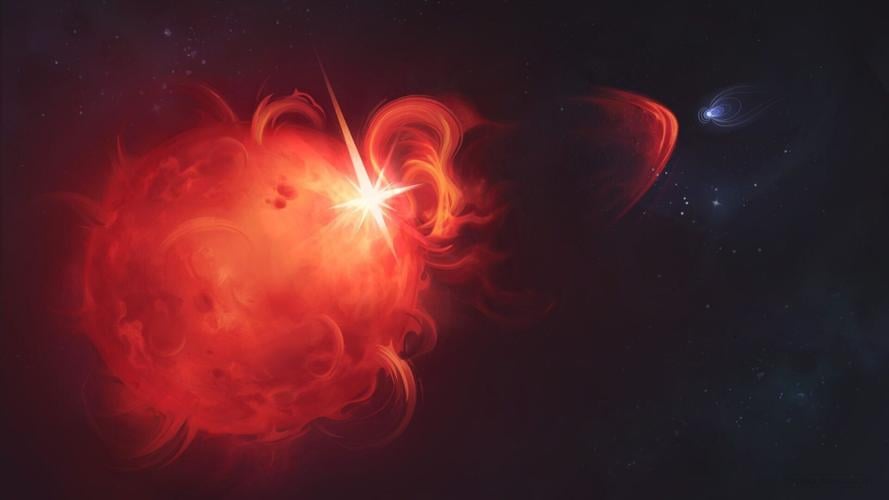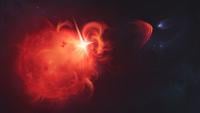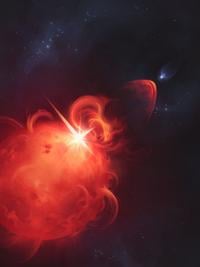
An artist's impression of a large red star releasing a bright, explosive burst of light. (Olena Shmahalo/Callingham et al. via SWNS)
By Stephen Beech
The first confirmed sighting of a giant explosion on a nearby star has been spotted by astronomers.
They observed an explosive burst of material thrown out into space by another star – a huge burst powerful enough to strip away the atmosphere of any planet in its path.
And they say the discovery is an "exciting" breakthrough in the search for alien life.
The burst was a coronal mass ejection (CME) - eruptions often seen coming from the Sun, according to astronomers using the European Space Agency’s XMM-Newton space observatory and the LOFAR telescope.
They explained that, during a CME, massive amounts of material are flung out from our star, flooding the surrounding space.
The dramatic expulsions shape and drive space weather - such as the dazzling auroras we see on Earth - and can chip away at the atmospheres of any nearby planets, according to a report published in the journal Nature.
But while CMEs are commonplace at the Sun, astronomers hadn’t definitely spotted one on another star – until now.
Report author Dr. Joe Callingham, of the Netherlands Institute for Radio Astronomy (ASTRON), said: “Astronomers have wanted to spot a CME on another star for decades.
“Previous findings have inferred that they exist, or hinted at their presence, but haven’t actually confirmed that material has definitively escaped out into space.
"We’ve now managed to do this for the first time.”

An artist's impression of XMM-Newton. (ESA-C. Carreau via SWNS)
He says as a CME travels through the layers of a star out into interplanetary space, it produces a shock wave and associated burst of radio waves.
The short, intense radio signal was picked up by Dr Callingham and his colleagues and found to come from a star lying around 40 light-years away - just under 15 times the diameter of the Solar System.
He said: “This kind of radio signal just wouldn’t exist unless material had completely left the star’s bubble of powerful magnetism.
“In other words: it’s caused by a CME.”
Dr Callingham says the matter-flinging star is a red dwarf – a type of star far fainter, cooler, and smaller than the Sun.
He said: "It is nothing like our own star: it has roughly half the mass, it rotates 20 times faster, and has a magnetic field 300 times more powerful.
"Most of the planets known to exist in the Milky Way orbit this kind of star."
The radio signal was spotted using the Low Frequency Array (LOFAR) radio telescope thanks to new data processing methods.
The team then used ESA’s XMM-Newton to determine the star’s temperature, rotation, and brightness in X-ray light, essential to interpret the radio signal and figure out what was actually going on.
Co-author David Konijn, a PhD student working at ASTRON, said: “We needed the sensitivity and frequency of LOFAR to detect the radio waves.
“And without XMM-Newton, we wouldn’t have been able to determine the CME’s motion or put it in a solar context, both crucial for proving what we’d found.
"Neither telescope alone would have been enough – we needed both.”

(Olena Shmahalo/Callingham et al. via SWNS)
The researchers determined the CME to be moving at a super-fast 2,400 km per second (1,500 miles per second), a speed only seen in one of every 20 CMEs taking place on the Sun.
The ejection was both fast and dense enough to completely strip away the atmospheres of any planets closely orbiting the star, according to the research team.
They say the atmosphere-stripping ability of the CME is an "exciting" discovery in the hunt for life around other stars.
The research team explained that a planet’s habitability for life as we know it is defined by its distance from its parent star – whether or not it sits within the star’s ‘habitable zone’, a region where liquid water can exist on the surface of planets with suitable atmospheres.
They say it is a "Goldilocks scenario" - too close to the star is too hot, too far is too cold, and in between is just right.
A planet regularly bombarded by powerful coronal mass ejections may lose its atmosphere entirely, leaving a barren rock behind – an uninhabitable world, despite its orbit being "just right".
Henrik Eklund, an ESA research fellow based at the European Space Research and Technology Centre (ESTEC) in the Netherlands, said: “This work opens up a new observational frontier for studying and understanding eruptions and space weather around other stars.
“We’re no longer limited to extrapolating our understanding of the Sun's CMEs to other stars. It seems that intense space weather may be even more extreme around smaller stars – the primary hosts of potentially habitable exoplanets.
"This has important implications for how these planets keep hold of their atmospheres and possibly remain habitable over time.”
ESA XMM-Newton project scientist Dr Erik Kuulkers added: “XMM-Newton is now helping us discover how CMEs vary by star, something that’s not only interesting in our study of stars and our Sun, but also our hunt for habitable worlds around other stars.
“It also demonstrates the immense power of collaboration, which underpins all successful science.
"The discovery was a true team effort, and resolves the decades-long search for CMEs beyond the Sun.”



















(0) comments
Welcome to the discussion.
Log In
Keep it Clean. Please avoid obscene, vulgar, lewd, racist or sexually-oriented language.
PLEASE TURN OFF YOUR CAPS LOCK.
Don't Threaten. Threats of harming another person will not be tolerated.
Be Truthful. Don't knowingly lie about anyone or anything.
Be Nice. No racism, sexism or any sort of -ism that is degrading to another person.
Be Proactive. Use the 'Report' link on each comment to let us know of abusive posts.
Share with Us. We'd love to hear eyewitness accounts, the history behind an article.